 Website:
Total Hygiene
Website:
Total Hygiene
Catalog excerpts

Considerations in the provision of toilet aids for children with disabilities. Guidance for occupational therapists. A Closomat White Paper
Open the catalog to page 1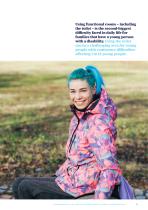
Using functional rooms – including the toilet – is the second-biggest difficulty faced in daily life for families that have a young person with a disability. Using the toilet can be a challenging area for young people with continence difficulties affecting 1 in 12 young people. A Closomat White Paper Considerations in the provision of toilet aids for children with disabilities
Open the catalog to page 2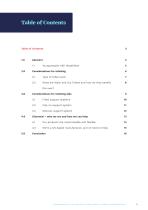
2.2 What are Wash and Dry Toilets and how do they benefit Young people with disabilities Type of toilet used Considerations for toileting aids Fixed support systems Clip-on support system Rollover support system Our products are customisable and flexible We’re a UK-based manufacturer, and on hand to help A Closomat White Paper Considerations in the provision of toilet aids for children with disabilities
Open the catalog to page 3
Young people go to the toilet on average eight times a day, even those without disabilities can struggle to access and functionally utilise the toilet affectively and independently. Common factors that often influence this are the toilet height, stability when using the toilet, or carrying out hygiene procedures. The ability to access the toilet independently, and carry out all of the functional aspects to complete hygiene tasks, is important to enable an improved level of independence with selfcare activities; this can promote feelings of confidence, self-worth, and dignity, subsequently...
Open the catalog to page 4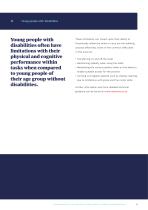
Young people with disabilities Young people with disabilities often have limitations with their physical and cognitive performance within tasks when compared to young people of their age group without disabilities. These limitations can impact upon their ability to functionally utilise the toilet or carry out the toileting process affectively. Some of the common difficulties in this area are: • ransferring on and off the toilet T • aintaining stability when using the toilet M • aintaining the correct position when on the toilet to M enable suitable access for the process • arrying out...
Open the catalog to page 5
To compensate for the young person’s difficulties with toileting there are a number of interventions that can be utilised to enable independence with toileting access and the activity itself. When deciding on the correct choice of intervention this should be led by the needs of the young person. It also has similar, corresponding benefits for the child’s carers and family. The choice of toilet aids is influenced by a number of factors: • ow long will the child need it h • ow capable is the child at transferring on/off h the toilet • hat level of support system may be required w • an the...
Open the catalog to page 6
Type of toilet used Is the child using a conventional WC or a wash and dry (shower) toilet? Whichever type of toilet is being used, the child needs to feel secure and stable. The child should be sat comfortably, with their back supported against the cistern, and their torso and legs forming approximately a 90° angle. The child’s buttocks should be supported but slightly parted to enable effective bowel evacuation. If a carer’s support is required, the carer needs to be able to provide appropriate intimate care easily. Consideration therefore needs to be given to access to intimate care...
Open the catalog to page 7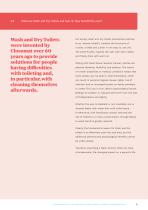
What are Wash and Dry Toilets and how do they benefit the user? Wash and Dry Toilets were invented by Closomat over 60 years ago to provide solutions for people having difficulties with toileting and, in particular, with cleaning themselves afterwards. Put simply, Wash and Dry toilets (sometimes referred to as “shower toilets”) combine the functions of a toilet, a bidet and a drier in one easy to use unit. The toilet flushes, washes the user with warm water, and finally dries with warm air. Wiping with toilet tissue requires manual, mental and physical dexterity, flexibility, and balance....
Open the catalog to page 8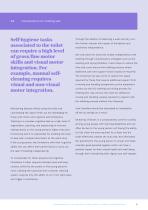
Considerations for toileting aids Self-hygiene tasks associated to the toilet can require a high level of gross/fine motor skills and visual motor integration. For example, manual selfcleaning requires visual and non-visual motor integration. Through the addition of selecting a wash and dry unit this further reduces the impact of limitations and maximises independence. Not only does the Closomat enable independence with toileting through compensatory strategies such as the washing and drying facilities, it also helps to reduce the time and costs around the toileting process where additional...
Open the catalog to page 9
Fixed support systems For a lot of children with more profound disabilities, some variant of support system will be required when using the Closomat to provide them with security and stability when sitting on the toilet, regardless of their level of mobility. A Closomat White Paper Lateral body supports are fitted to the WC to provide stability on both sides of the trunk. These are beneficial for young people with muscle weaknesses or imbalances that result in them having poor core stability and therefore maintaining an upright sitting position. You will often see these young people in...
Open the catalog to page 10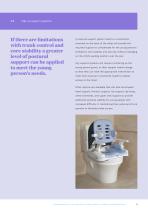
Clip-on support systems If there are limitations with trunk control and core stability a greater level of postural support can be applied to meet the young person’s needs. A postural support system fixed to a mechanism mounted on the back of the toilet will provide the required support to compensate for the young person’s limitations with stability and security without impinging on the child’s seating position over the pan. Any support systems will require monitoring as the young person grows, or their support needs change, so that they can have the appropriate intervention to meet their...
Open the catalog to page 11
Rollover support systems These can offer the same level of postural support as the clip-on systems but can roll over the toilet, enabling the young person to access the toilet without a clip-on support system needing to be fitted prior to accessing the toilet. The latest evolution is a HTS (hygiene & toileting system) which like the clip-on system provides head support, thoracic supports, hip supports, lap straps, chest harnesses, and upper limb support, but also has the addition of a foot support which can be beneficial for those where the toilet height means they are unable to reach the...
Open the catalog to page 12All Total Hygiene catalogs and technical brochures
-
CP CB 3-7 Changing Bench
1 Pages
-
CP CBM 9 Changing Bench
1 Pages
-
Hoist system
2 Pages
-
Bariatric Palma
18 Pages
-
Products & Services
40 Pages
-
Changing Places BS8300:2009
12 Pages
-
Accessible bathrooms
8 Pages
-
Care Package
8 Pages
-
Hygiene Rooms
8 Pages
-
Big John toilet Seat
1 Pages
-
Palma Vita Brochure
24 Pages
-
Aerolet Range
8 Pages
















